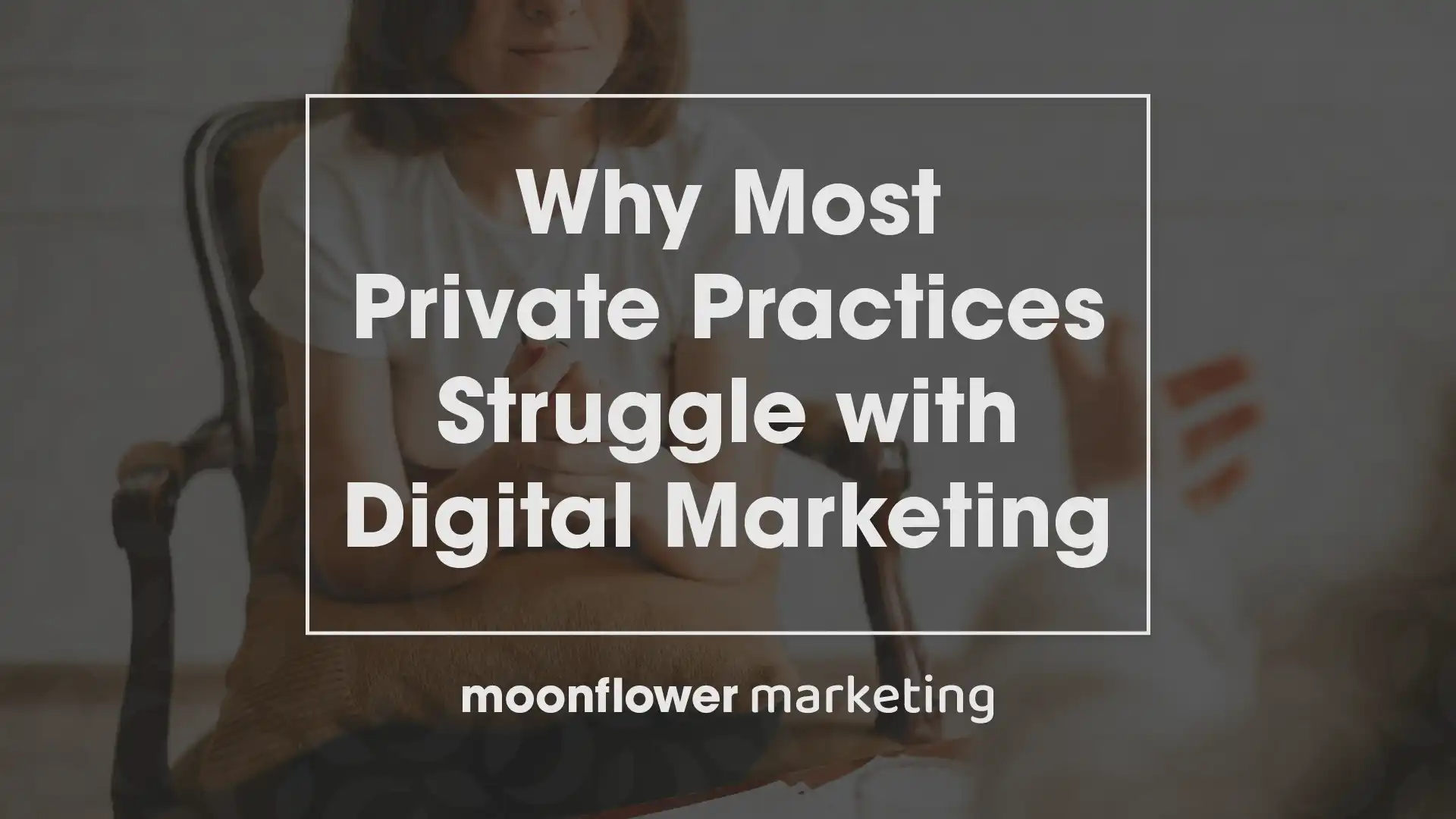After working with many private practices in the health and wellness, legal, and financial industries, I’ve learned something…
Almost all of them are really bad at digital marketing. They don’t understand or know how to leverage it to grow their practice.
Yet, they KNOW they need it.
Word of mouth and referrals only go so far. Even more, if your website, local listings, social media, and other digital marketing efforts are subpar, it can even cost you referral business.
The Digital Marketing Struggle: Why Your Efforts Aren’t Paying Off
Running a private practice means wearing many hats—but “digital marketing expert” wasn’t one you signed up for. Yet, if your website isn’t bringing in leads, your social media feels like a black hole, and your competitors always rank higher on Google, you might feel stuck.
The truth? Most private practices struggle with digital marketing because they lack a clear, strategic approach. Instead of attracting and converting clients, they rely on scattered efforts that fail to build trust and authority.
Today’s post will break down some common pitfalls private practices face and the proven solutions to turn digital marketing into a reliable source of new clients.
Why Most Private Practices Fail at Digital Marketing
Let’s dive in.
1. They Talk About Themselves Instead of Their Clients
Many private practice websites focus on credentials, years of experience, and services offered. While these details matter, they don’t answer the primary question a potential client is asking:
“Can you help me solve my problem?”
People aren’t looking for a therapist, lawyer, or chiropractor—they’re looking for relief from anxiety, legal trouble, or chronic pain. If your messaging doesn’t immediately address their pain points, they’ll move on.
2. They Have No Clear Calls to Action (or Too Many)
A website without clear next steps is like a road with no signs. Visitors shouldn’t have to guess what to do next.
Many practices fall into two traps:
- No Calls to Action (CTA): Visitors leave because they don’t know what to do.
- Too Many CTAs: Too many options create decision fatigue, leading people to leave without taking action.
I once worked with a law firm with seven calls to action on their home page.
- Contact Us
- Fill Out This Form for Criminal Law
- Fill Out This Form for Personal Injury
- Fill Out This Form for Family Law
- Download This Guide to Family Law
- Download This Guide to Criminal Law
- Download This Guide to Personal Injury
My head is still spinning…
3. They Neglect SEO (Search Engine Optimization)
Most people find local service providers by searching “[service] near me.” If your practice isn’t optimized for search engines, you’re invisible to potential clients.
SEO isn’t just about ranking higher—it’s about showing up when it matters most. Many private practices ignore critical SEO elements like:
- Optimizing their Google Business Profile
- Gathering client reviews to boost credibility
- Using local keywords in website content
4. They Have No Lead Nurturing Strategy
Even if someone finds your website, they may not book an appointment immediately. Without a lead generation and follow-up system, potential clients slip through the cracks.
Capturing email addresses and nurturing leads with valuable content (like a free guide or email series) keeps your practice top of mind until they’re ready to commit.
How to Fix Your Private Practice’s Digital Marketing
Step 1: Make Your Client the Hero of the Story
Instead of positioning your practice as the hero, you should be the guide helping your client overcome their struggles. Be Yoda to their Skywalker.
Action Step: Rewrite your homepage to clearly answer:
- What problem does your client have?
- How do they feel about that problem?
- What does success look like after working with you?
Example: Instead of just saying, “We have 15 years of experience in family law,” say,
“You can’t risk losing your children. We help you protect your family and their future.”
Step 2: Structure Your Website for Conversions
Your website should do more than look nice—it should drive action.
What Your Homepage Needs:
A Clear Headline – Speak directly to client pain points and your solution.
- Example: “Struggling with anxiety? We help you regain control.”
A Simple Call to Action (CTA) – Make it obvious what they should do next.
- Example: “Schedule a Free Consultation” (instead of vague buttons like “Learn More”)
The Stakes – Explain what happens if they don’t take action.
- Example: “Don’t let stress take over your life. Get help today.”
Step 3: Use Two Clear Calls to Action (No More, No Less)
Your website should have two CTAs strategically placed throughout.
Direct Call to Action (DCTA) – The main action you want them to take
- Book an Appointment
- Schedule a Call
- Talk to an Expert
Transitional Call to Action (TCTA) – A low-commitment step for those not ready to book
- Download Our Free Checklist or Guide (“5 Things to Know Before Choosing a Therapist”)
- Get Our Free Video Series
- Watch our Free Webinar
- Get Our Email Course
Pro Tip: Add these CTAs throughout your website—not just on the homepage.
Step 4: Optimize for Local SEO
If you’re not ranking on Google, your ideal clients won’t find you.
Quick SEO Wins for Private Practices:
- Claim Your Google Business Profile – Ensure your practice appears in local searches.
- Ensure Your Website is Mobile-Friendly – Most searches happen on phones.
- Get Client Reviews – Google prioritizes businesses with frequent, high-quality reviews. Look to see how many average reviews your competitors have and try to be in that range or higher.
- Use Local Keywords – Example: Instead of “Therapy Services,” use “Therapist in [City].”
- Make sure you’re listed in every major local listing site (Google, Bing, Yelp, YellowPages, etc.), all with identical contact information. Sites like YEXT are great tools for making this process way easier.
These simple actions increase visibility and put you ahead of competitors.
Step 5: Capture Leads & Follow Up
Most visitors won’t book an appointment on their first visit. That’s why you need email marketing to nurture them.
Example Email Series for Private Practices:
- Welcome Email: Thank them for downloading your free guide.
- Value-Driven Email: Share a client success story or a helpful tip.
- Call to Action Email: Invite them to schedule a consultation.
Pro Tip: Set up an automated email sequence to keep your practice top of mind. Your CRM (Client Relationship Management) software might have email automation capabilities. If not, we LOVE and use KIT.
The Bottom Line: Align Your Marketing with Your Clients’ Story
When your digital marketing is clear, strategic, and client-focused, everything changes. Instead of wasting time on tactics that don’t work, you’ll have a system that attracts, engages, and converts the right clients.
Action Step: Start with one change today—whether it’s clarifying your website messaging, setting up a lead generator, or optimizing for SEO.
Your private practice exists to help the people in your community live better lives, so it deserves to thrive.
If we can help, schedule a Free Consultation. We’ll spend 30 minutes with you over Zoom to learn about your business and how we can help you succeed.





0 Comments